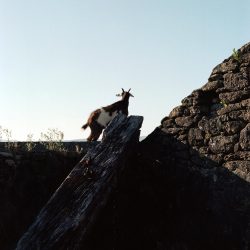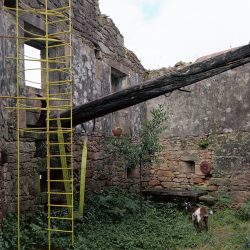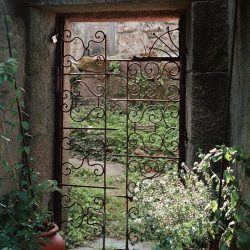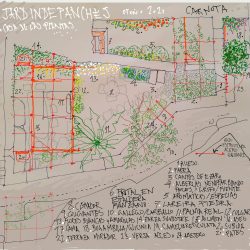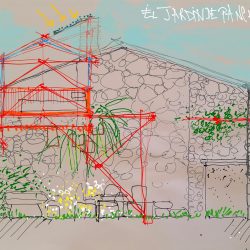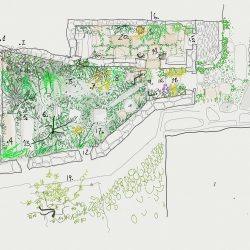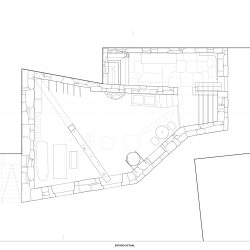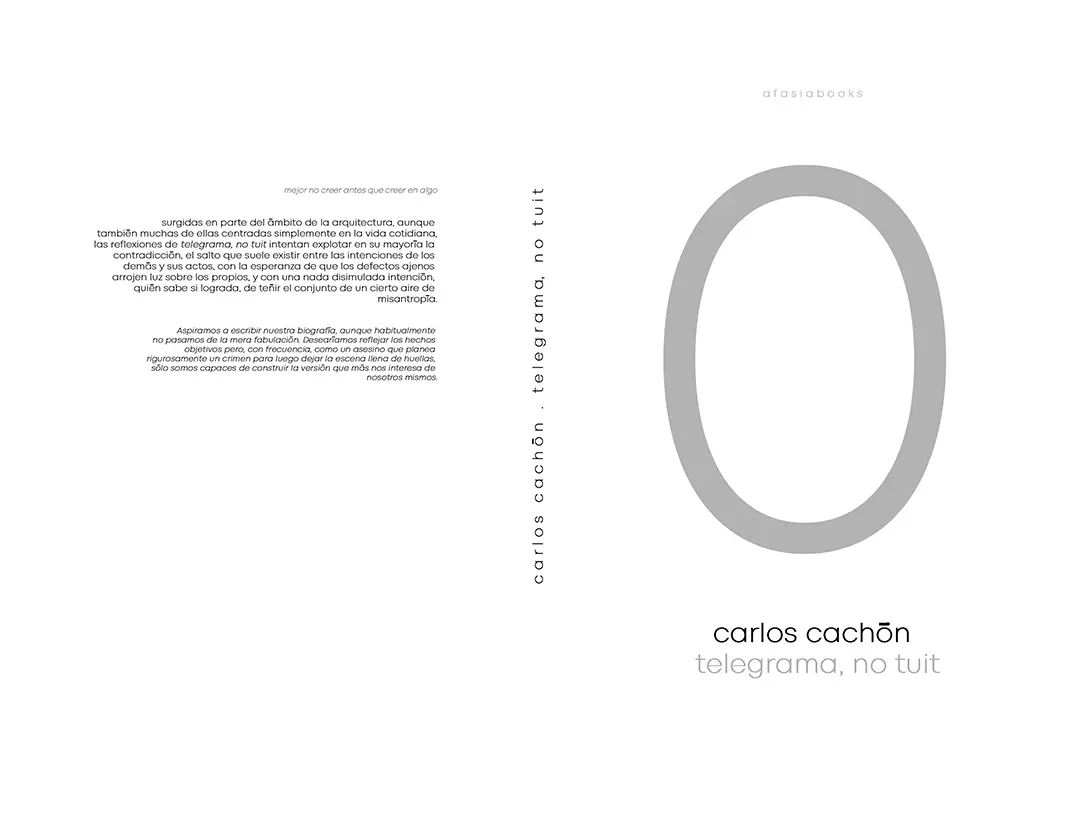
Arturo Franco Díaz . photos: © Luis Diaz Diaz
In October 2021 we found a piece of impenetrable mountain inside the oldest house in Panchés. A place by the sea, at the foot of Monte Pindo, at the end of the endless beach of Carnota.
01_THE ENCOUNTER.
I came from shooting 26 programs for “Jardines con Historia” by Timezone Producciones. I arrived eager to come face to face with the “garden idea”. What a garden would be like for me or maybe what I would be like for a garden…an absent gardener.
Here begins that story.
02_THE FIRST GARDENS.
One invents nothing…or very little. To advance by going backwards consists of relying on the art of looking, of unveiling, of knowing how to copy, to interpret or to combine different realities until reaching others. The first gardener must have looked at nature, at the nature that wanted to be a garden and to be associated with the stones. El Pindo and its surroundings are full of natural gardens where the mountain makes its way without the permission of gardeners or architects. Roofless constructions that end up being, with time, the home of the silvas…
03_THE PLANTS OF MOUNT PINDO
Galicia is marela (yellow) or so says Rocío, the owner of the best nursery in the area. If anyone knows the inhabitants of the mountain it is her. Yellow because of the small flowers of the Xestas or the Toxo that stain these slopes with the color of bad luck. With its deep roots there is no one who can pull them out of this land and if something is so eager to stay here… well, let it stay. But Galicia is also a land of “weeds” with spikes and hives. Impertinent plants, fucking uncomfortable. Maybe that’s why I find them so attractive.
04_A RAPA DAS ZARZAS
During the summers in the “curros” the feral horses are collected to proceed to cut the manes, deworm them and cure the wounds during the Rapa das Bestas.
During the winter and while the plants sleep, we began to clear the path. They were appearing lareiras, fornos de pedra as bellies, swellings in the walls, pias, lacenas, banks and in the background the sea of the end of the world.
05_THE FIRST INTERVENTIONS
First we cleared, cleaned and emptied the house of debris. We removed, sorted and classified the remains of the roof that collapsed 40 years ago. Hundreds of tiles, soil and domestic archeology were appearing. Irons, flanges, watering cans, stirrups, bottles, animal skulls… We respected some of the original silvas and many of the ferns and mosses that had lived there for years.
The rest was cleaned up and new topsoil was added. The first spring it was filled with nettles, an ocean of stinging plants…The second spring with a small invasive plant whose name I have not discovered. Little by little the silvas, the ferns and even a small wild rose bush recovered space.
Then came the large punt beam to break up the space. To drop down there like a dead animal and generate tension. A ton of eucalyptus wood that had been submerged in the Noia estuary for more than 20 years. Cursed tree in these lands, but so dear to us, like the rest of the eucalyptus trees.
Later came the carajo (staircase-viewpoint to the sea of steel rounds) and the swing (yellow sling with a stone as a seat), the disc table to cut granite and chat and the access door from a nearby cemetery. There is no garden without a gate and this would have to be the gate to hell.
The rest of the elements were appearing or peeking out in search of the sun, attracting attention like the plants every spring, like the guests at a wedding, piled up during the first minutes of an open bar.
06_THE NEIGHBORS
When the gardener remains absent, the plants are liberated, they know it and take advantage of his absence like children when they are left home alone. Anything can happen. But to the right and left are the neighbors watching out in case something gets out of hand. Jorge who worked on the land, Ana who brings us herba de namorar and the money plant and, as it could not be otherwise, in this garden of spikes both were short-lived.
07_PLANTS AND EXPERTS
There is only one thing worse than an absent gardener for a garden… an inexperienced gardener.
To solve this problem, Ana Isabel Calo, owner of Casa das Camelias in Boiro, Miguel Llana, the passionate banker, Rafael Ovalle (Falo), a renowned landscape gardener from Asturias, and Rocio Priegue, the owner of the nursery in Cee. Together we designed a process of renaturalization of the future garden. We traced a route through Monte Pindo to collect from the margins
08_ AT THE STARTING POINT
Time has taken care of everything else until we reach the starting point. Everything is as it was at the beginning, but different.
“One throws a stone into the water: the sand swirls up and settles again. The disturbance was necessary, and the stone has found its place. However, the pond is no longer the same as before. Buildings are accepted in their environment when they possess multiple ways of speaking from feeling and reason” Peter Zumthor
_
01_EL ENCUENTRO. En octubre del año 2021 encontramos un trozo de monte impenetrable en el interior de la casa más vieja de Panchés. Un lugar junto al mar, a las faldas del Monte Pindo, al final de la infinita playa de Carnota. Venía de rodar 26 programas para @la2_tve llamados "Jardines con Historia" de @timezoneproducciones. Llegué con muchas ganas de enfrentarme cara a cara con la "idea de jardín". Cómo sería un jardín para mi o tal vez cómo sería yo para un jardín...un jardinero ausente. Aquí comienza esa historia. 02_LOS PRIMEROS JARDINES. Uno no se inventa nada...o muy poco. Avanzar retrocediendo consiste en apoyarse en el arte de mirar, de desvelar, de saber copiar, de interpretar o de combinar distintas realidades hasta alcanzar otras. El primer jardinero debió fijarse en la naturaleza, en la naturaleza que quiso ser jardín y asociarse con las piedras. El Pindo y sus alrededores está lleno de jardines naturales donde el monte se abre paso sin permiso de jardineros ni arquitectos. Construcciones sin techo que acaban siendo, con el tiempo, el hogar de las silvas... 03_LAS PLANTAS DEL MONTE PINDO Galicia es marela (amarilla) o al menos eso dice Rocío la propietaria del mejor vivero de la zona. Si alguien conoce a los habitantes del monte es ella. Amarilla por las pequeñas flores de las Xestas o el Toxo que tiñen del color de la mala suerte estas laderas. Con sus raíces profundas no hay quien las arranque de esta tierra y si algo tiene tantas ganas de quedarse aquí... pues que se quede. Pero Galicia también es tierra de "malas hierbas" de pinchos y urticarias. Plantas impertinentes, jodidamente incómodas. Tal vez por eso me resulten tan atractivas. 04_A RAPA DAS ZARZAS Durante los veranos en los "curros" se recogen los caballos asilvestrados para proceder al corte de las crines, desparasitarlos y curarles las heridas durante a Rapa das Bestas. Nosotros durante el invierno y mientras las plantas duermen comenzamos a despejar el camino. Fueron apareciendo lareiras, fornos de pedra como barrigas, hinchazones en los muros, pías, lacenas, bancos y al fondo el mar del fin del mundo. 05_LAS PRIMERAS INTERVENCIONES Primero desbrozamos, limpiamos y vaciamos de escombros la casa. Retiramos, ordenamos y clasificamos los restos de la cubierta desplomada 40 años atrás. Cientos de tejas, tierra y arqueología doméstica fueron apareciendo. Planchas, bridas, regaderas, estribos, botellas, cráneos de animales…Respetamos algunas de las silvas originales y muchos de los helechos y musgos que allí habían vivido durante años. El resto se saneó y se aportó nueva tierra vegetal. La primera primavera aquello se llenó de ortigas, un océano de plantas urticantes…La segunda primavera de una pequeña planta invasora cuyo nombre no he llegado a descubrir. Poco a poco fueron recuperando espacio las silvas, los helechos y hasta un pequeño rosal silvestre. Entonces llegó la gran viga de batea para romper el espacio. Para dejarse caer por ahí como un animal muerto y generar tensión. Una tonelada de madera de eucalipto que llevaba sumergida en la ría de Noia más de 20 años. Árbol maldito por estas tierras, pero tan querido para nosotros, como el resto de malas hierbas en este jardín miserable e incómodo. Mas tarde llegaron el carajo (escalera-mirador hacia el mar de redondos de acero) y el columpio (Eslinga amarilla con una piedra a modo de asiento), la mesa de disco para cortar granito y charlar y la puerta de acceso procedente de un cementerio cercano. No hay jardín sin puerta y esta tendría que ser la puerta del infierno. El resto de los elementos fueron apareciendo o se fueron asomando en busca del sol, llamando la atención como las plantas cada primavera, como los invitados de una boda, amontonados durante los primeros minutos de una barra libre. 06_LOS VECINOS Cuando el jardinero permanece ausente, las plantas se liberan, lo saben y se aprovechan de su ausencia como los niños cuando se quedan solos en casa. Todo puede pasar. Pero a derecha e izquierda están los vecinos vigilantes por si algo se desmadra. Jorge que trabajó en la tierra, Ana que nos trae herba de namorar y la planta del dinero y, como no podía ser de otro modo, en este jardín de pinchos ambas duraron poco. 07_LAS PLANTAS Y LOS EXPERTOS Solo hay algo peor que un jardinero ausente para un jardín…un jardinero inexperto. Para solucionar ese problema fueron apareciendo Ana Isabel Calo, propietaria de la casa das Camelias en Boiro, Miguel Llana, el bancario apasionado, Rafael Ovalle (Falo), un reputado paisajista asturiano, y Rocio Priegue, la propietaria del vivero de Cee. Entre todos diseñamos un proceso de renaturalización del futuro jardín. Trazamos un recorrido por el Monte Pindo para recoger de los márgenes de los senderos las especies silvestres que invitaríamos a habitar el jardín en compañía de las silvas y helechos que habían sobrevivido a nuestra llegada. 08_ EN EL PUNTO DE PARTIDA El tiempo se ha encargado de todo lo demás hasta llegar al punto de partida. Todo es como al principio, pero distinto. “Uno arroja una piedra al agua: la arena se arremolina y vuelve a asentarse. La perturbación fue necesaria, y la piedra ha encontrado su sitio. Sin embargo, el estanque ya no es el mismo que antes. Los edificios son aceptados en su entorno cuando poseen múltiples maneras de hablar desde el sentimiento y la razón” Peter Zumthor Arturo Franco. Otoño de 2024





